Building on talent and tradition, ceramic artists leave their mark through clay creations in the Mint’s permanent collection
By Annie Carlano, Senior Curator of Craft, Design & Fashion, and Rebecca Elliot, Assistant Curator of Craft, Design & Fashion
Locally, across the country, and across the pond, North Carolina is known as the “clay state.” With an abundance of clay in the soil from the Piedmont to the mountains, centuries of pottery making, and generations of families making objects of exceptional craft and design, by the early 20th century an appreciation for North Carolina ceramics grew. In the 1960s, amid the back-to-the-earth cultural movement, pottery was collected, exhibited, and published widely, and the was the subject of scholarly inquiries and symposia.
Building on the talent and traditions of the past, in the 21st century, North Carolina has attracted potters and sculptors from throughout the world who seek good local clay bodies, but a community of makers and a lifestyle that values simplicity.
North Carolina ceramics is one of the great strengths of the Mint Museum’s permanent collection. Its contemporary holdings continue to grow through the generosity of many individuals. Striving to represent the full range of artistic production throughout the state, the Mint has amassed a collection that includes jugs, tableware, sculpture, and installation art. A sampling is featured here for your enjoyment.
Fine functional and decorative objects are also featured in the Mint Museum Store at Mint Museum Uptown.
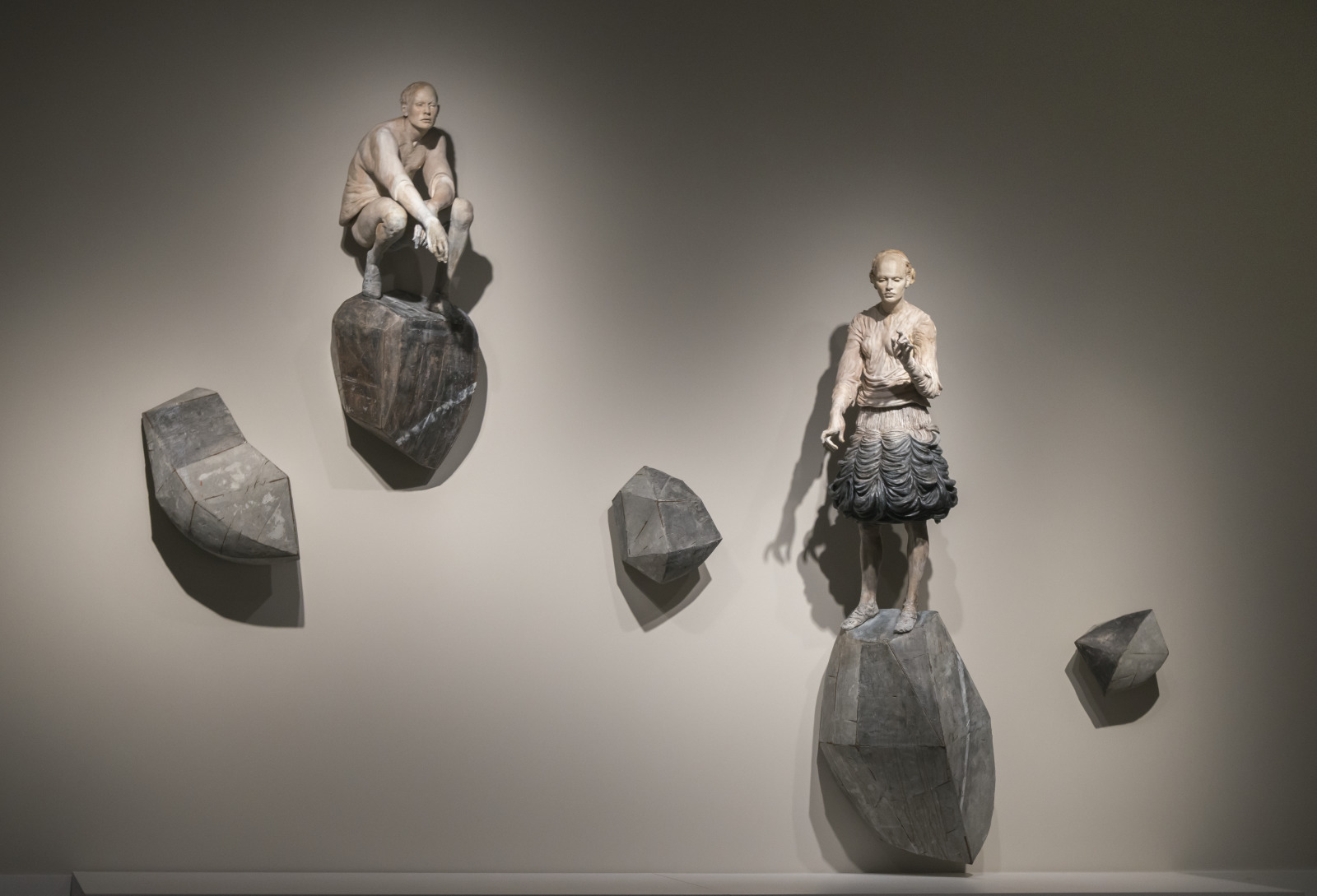
Cristina Córdova (United States, 1976-). Preludios y Partidas, 2012, ceramic, concrete, steel, resin, 129.5 x 36 x 180 inches. Project Ten Ten Ten Commission. Museum Purchase: Funds provided by Laura and Michael Grace, Donna and Al De Molina, Lorne Lassiter and Gary Ferraro, and Yvonne and Richard McCracken. 2014.30A-J. Image © Mint Museum of Art, Inc. © Cristina Córdova, 2012.
Cristina Córdova’s figurative installation, Preludios y Partidas, commands a wall at one end of the Clay Gallery on Level 3 at Mint Museum Uptown. This subtle yet powerful psychological work was created nearly a decade ago yet is prescient. Córdova says: “In understanding this piece as a metaphorical topography, I wanted to use the title to hint as to what that corresponding psycho-emotional space would be. This landscape is one of transition and like the reference to the distillment of reason and logic from uncertainty and chaos, these figures are in the preliminary charged states (preludios) before a great action (partidas). Although the floating concrete elements could hint of the residual vestiges of a previous reality, I am not thinking of it as further leading to an ending but to the beginning of a new cycle. Common to the human experience are profound shifts where the ground gives way and one is thrust into powerful periods of self-reflection, growth, and renewed vision; this is how this space looks in my mind right before the next grand launch.”
Born in Boston, raised in Puerto Rico, Córdova received a BA, magna cum laude, University of Puerto Rico at Mayagüez, Colegio de Agricultura y Artes Mecánicas, Mayagüez, Puerto Rico, in 1998, and an MFA in Ceramics from New York State College of Ceramics, Alfred University, Alfred, New York, in 2002. Her sculptures are included in other prestigious museum collections including the Renwick Gallery of the Smithsonian American Art Museum in Washington, D.C., Fuller Craft Museum in Massachusetts, Museum of Contemporary Art of Puerto Rico, and the Mobile Museum in Alabama, as well as important private collections. The recipient of numerous awards and honors, she currently lives and works at Penland School of Craft in the Blue Ridge Mountains of North Carolina.
[cs_divider]
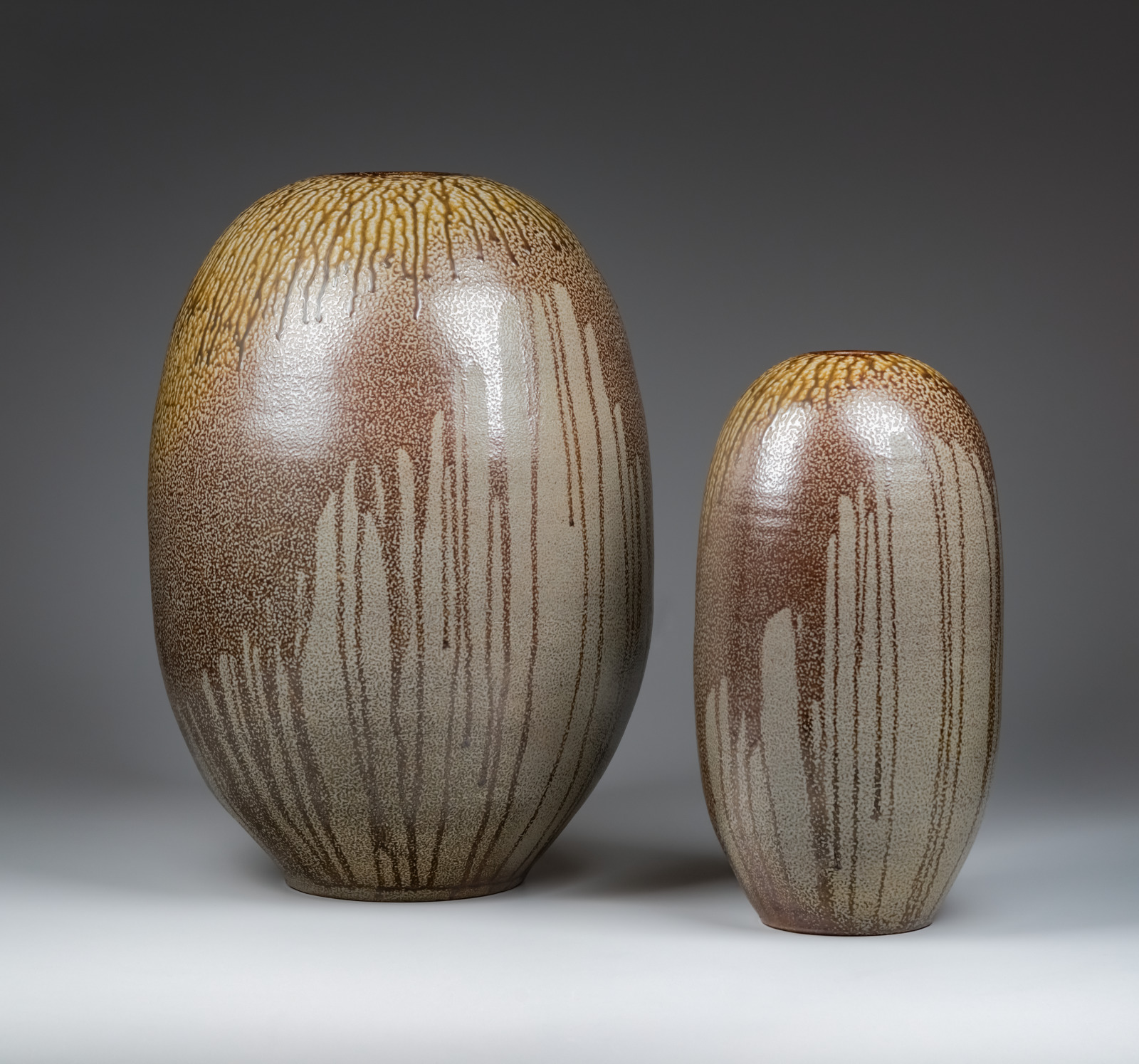
Alexander Matisse (United States, 1984-), East Fork Pottery (Asheville, NC, founded 2010). Two Tall Vases, clay, glaze, 26 x 16 inches. Gift of the Delhom Service League: 2014 Potters Market Invitational Purchase. 2014.74.1a-b. © Alexander Matisse, 2014
Two Tall Vases form an elegant sculptural pair illustrating the skill and aesthetic of clay artist and entrepreneur Alex Matisse. The large vessel forms are beautifully shaped with hints of the handmade in the faint throwing lines and gracefully manipulated drip glazes. Based on traditional North Carolina storage jugs and inspired by English and Asian wares, Two Tall Vases signal a transitional period in Matisse’s career, when his mastery of regional forms and global techniques led to a period of experimentation and the emergence of his unique contemporary style.
Matisse grew up in Groton, Massachusetts and studied at Guilford College in Greensboro, North Carolina where he discovered the rich history of the ceramics of our state. Dropping out of college to undertake apprenticeships with Matt Jones and Mark Hewitt, he started East Fork Pottery at the age of 25 along with his now wife Connie Coady Matisse, and John Vigeland. East Fork Pottery was founded on the principles of William Morris (British, 1834- 1896) that life is improved by living with objects that are beautiful, handmade, useful, and affordable. With their clean lines and muted colors, the simple everyday tableware and objects are staples in several restaurant dining rooms and are popular on wedding registries.
[cs_divider]
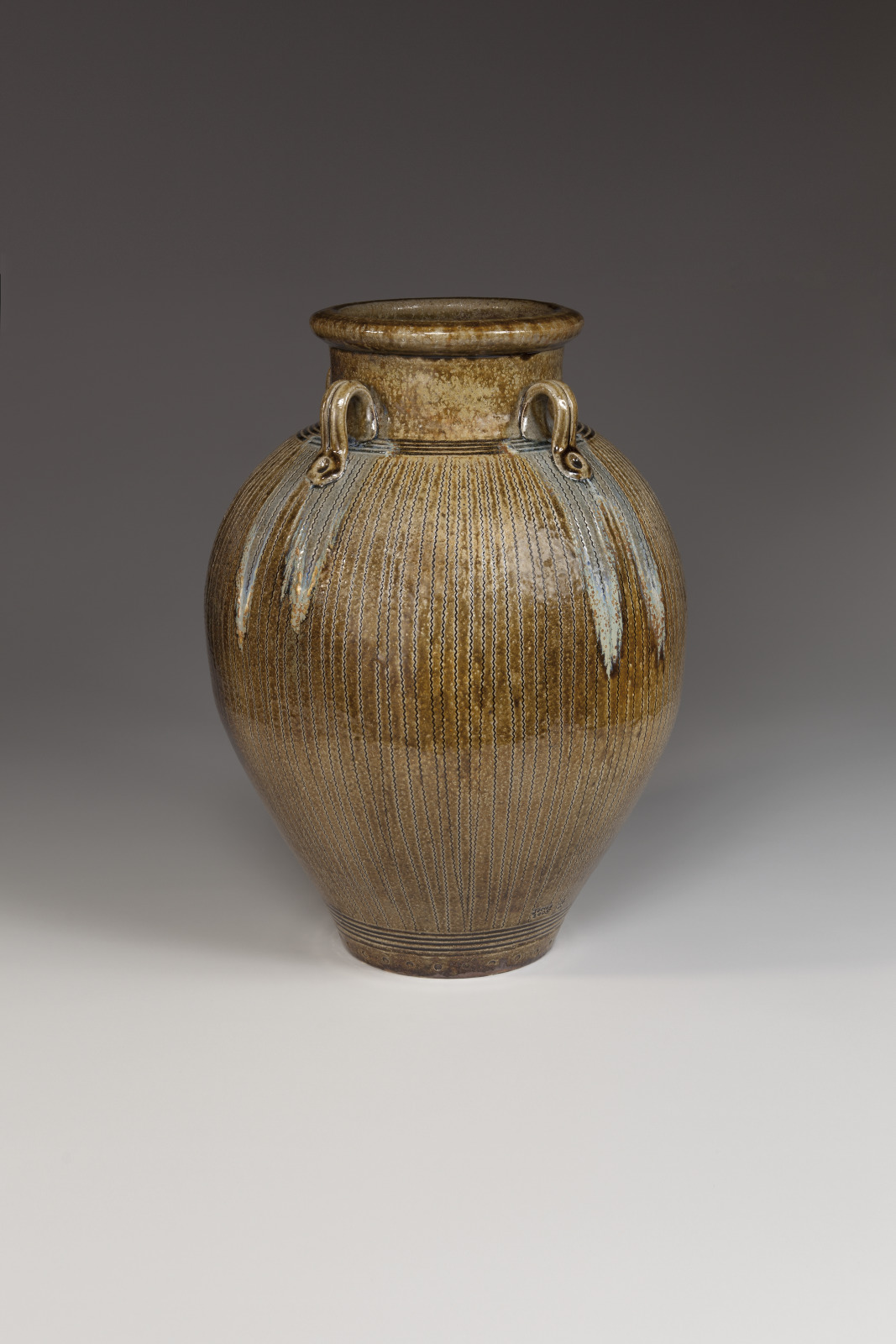
Matthew S. Jones (United States 1971-). Storage Jar, stoneware, 20 x 15.5 inches. Gift of an Anonymous Donor to Commemorate the First Potters Market Invitational. 2005.73.1. © Matthew S. Jones, 2005
In Storage Jar, with its broad strong rim, a robust vernacular shape is transformed into an elegant vessel, through its small delicate handles, surfaces markings, and glaze. Matt Jones achieves a timelessness in this and other works in the Mint’s collection through his deep knowledge and mastery of historic forms, the wood firing process, salt and alkaline glazes, and slip trailing. According to Jones, “It is important to me that my work is grounded in the Carolina traditions that go back 150 years, but I feel quite free to incorporate a modern sensibility and ideas from other cultures.”
Matt Jones fell in love with clay as a student at Earlham College in Indiana. His academic education was followed by an apprenticeship with Todd Piker at Cornwall Bridge Pottery in Connecticut, and another with Mark Hewitt of Pittsboro, North Carolina. In 1998 Jones set up his own pottery studio in Leicester, North Carolina. Today the studio is owned and run by Matt and his wife Christine. Using blue pipe clay—so named because it was once used to make pipe tobacco heads—Matt Jones continues to make a variety of garden pots and vessels.
[cs_divider]
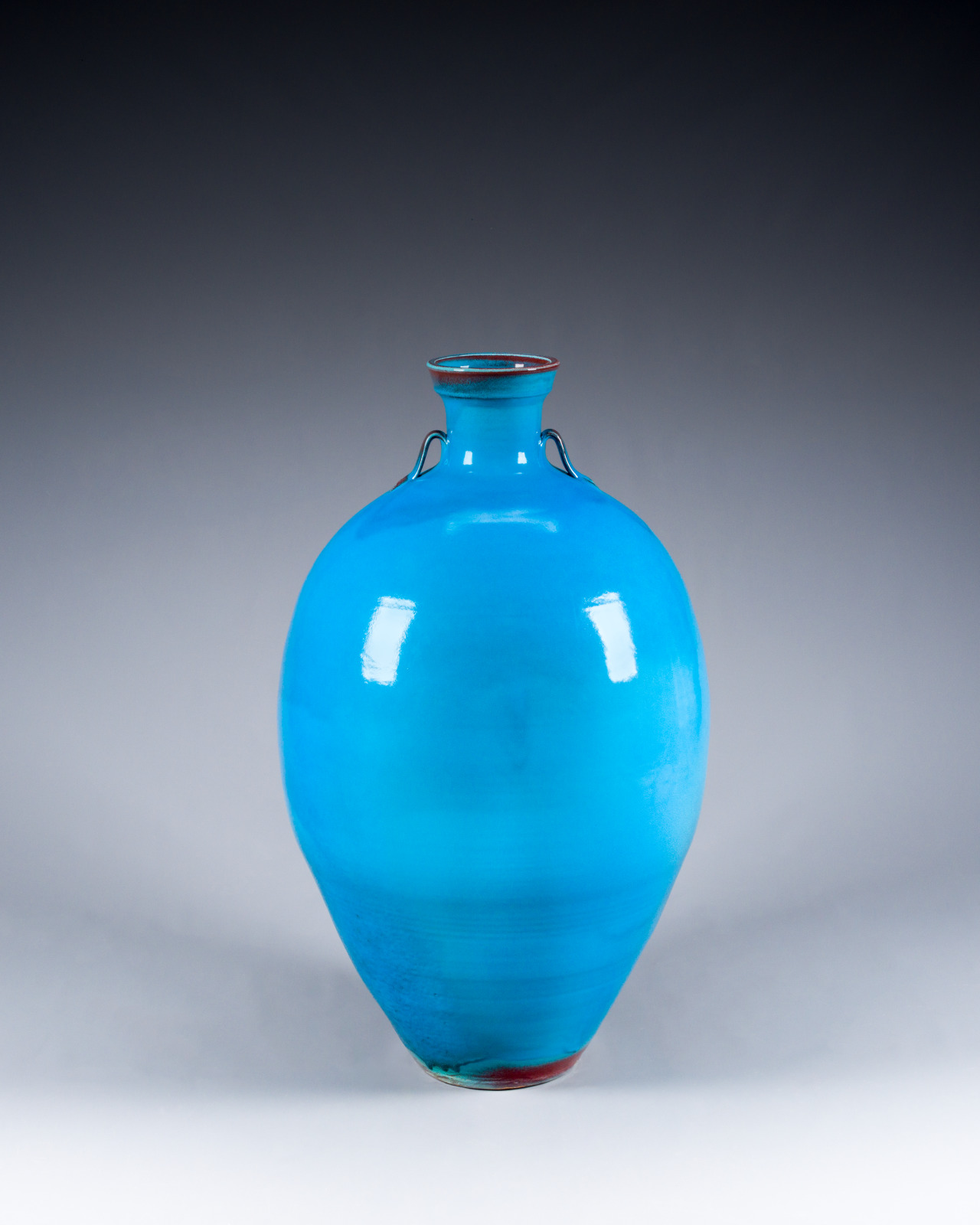
Benjamin W. Owen lll (American, 1968-). MiSe Vase, 2016, stoneware, 41 x 24 inches. Daisy Wade Bridges Purchase Prize from the 2016 Potters Market Invitational, given by the Delhom Service League. 2016.38.1
The MiSe Vase is a stunning example of Ben Owen III’s artistry. Though massive in size, it is perfectly symmetrical, displaying Owen’s great skill in throwing pots at any scale. The vessel’s rich blue color with hints of burgundy around the rim and on the handles demonstrates his mastery of a wide variety of glazes and his willingness to continually push himself to develop new glaze types. Its shape and the title MiSe reflect his knowledge of Asian ceramics, especially the Chinese ceramics tradition. In 2007, Owen traveled to China as part of a delegation of American political and community leaders and had the honor of presenting his work as gifts for the delegation’s Chinese hosts. During that trip, he also visited museums and pottery villages in China and Japan.
Owen comes from a long line of potters who settled North Carolina in the eighteenth century and made functional wares for the next two hundred years. Owen learned pottery beginning at the age of 8 from his grandfather, Ben Owen Sr., who had worked at Jugtown Pottery near Seagrove and later established his own pottery, Old Plank Road Pottery in Westmoore, North Carolina. Ben Owen III studied business at Pfeiffer University and earned a BFA in ceramics from East Carolina University in 1993. During the 1990s, he traveled to visit potters in Japan, Australia, and New Zealand. Since 1999, he has operated his own studio at the Old Plank Road Pottery.
[cs_divider]
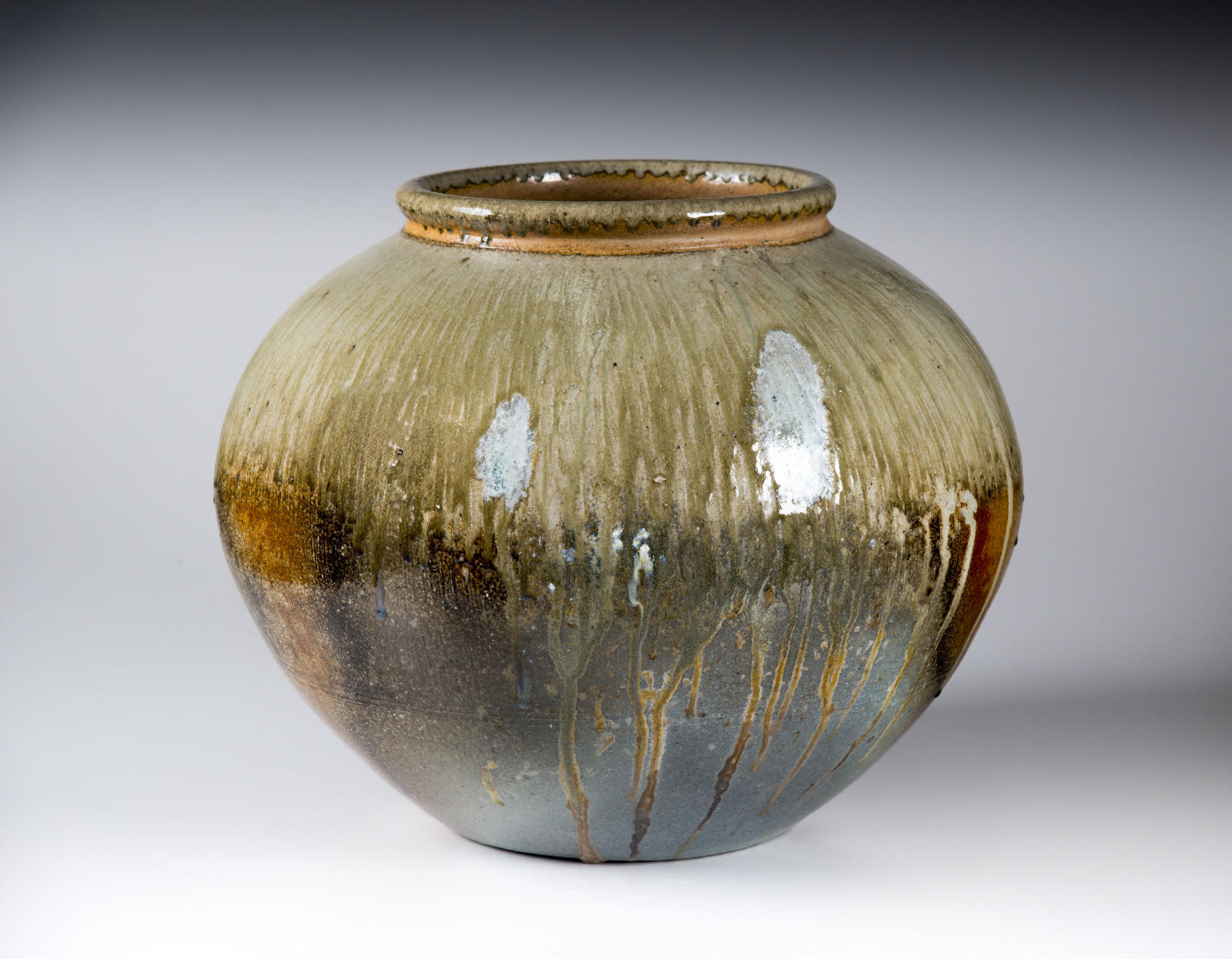
David Stuempfle (American, 1960-). Large Jar, 2012, stoneware, 17.5 x 21 inches. Gift of Daisy Wade Bridges. 2012.75.1
This Large Jar by David Stuempfle illustrates his skill at throwing large forms and achieving interesting glazing effects solely through the chemical reaction of clay and wood ash in the kiln. Dripping lines of brown and splotches of off-white add visual interest and complement the jar’s round form, accenting its background hues of rich brown, beige, and charcoal gray. Stuempfle makes his own clay body and slip from a mix of clay from his land and elsewhere in Seagrove, North Carolina, and commercially mined clays.
Originally from Gettysburg, Pennsylvania, Stuempfle first studied ceramics at the High Mowing School in New Hampshire. He then worked for many years as a journeyman potter in various states, including Tennessee and Wisconsin, as well as in Asia. When he relocated to North Carolina, he worked first for M.L. Owens Pottery and Jugtown Pottery before settling permanently in Seagrove. He built his wood-burning kiln there in 1992 and specialized in salt-glazed stoneware for several years but has recently stopped using salt glaze. His sources of inspiration include Chinese, Japanese, and Korean pottery.
[cs_divider]
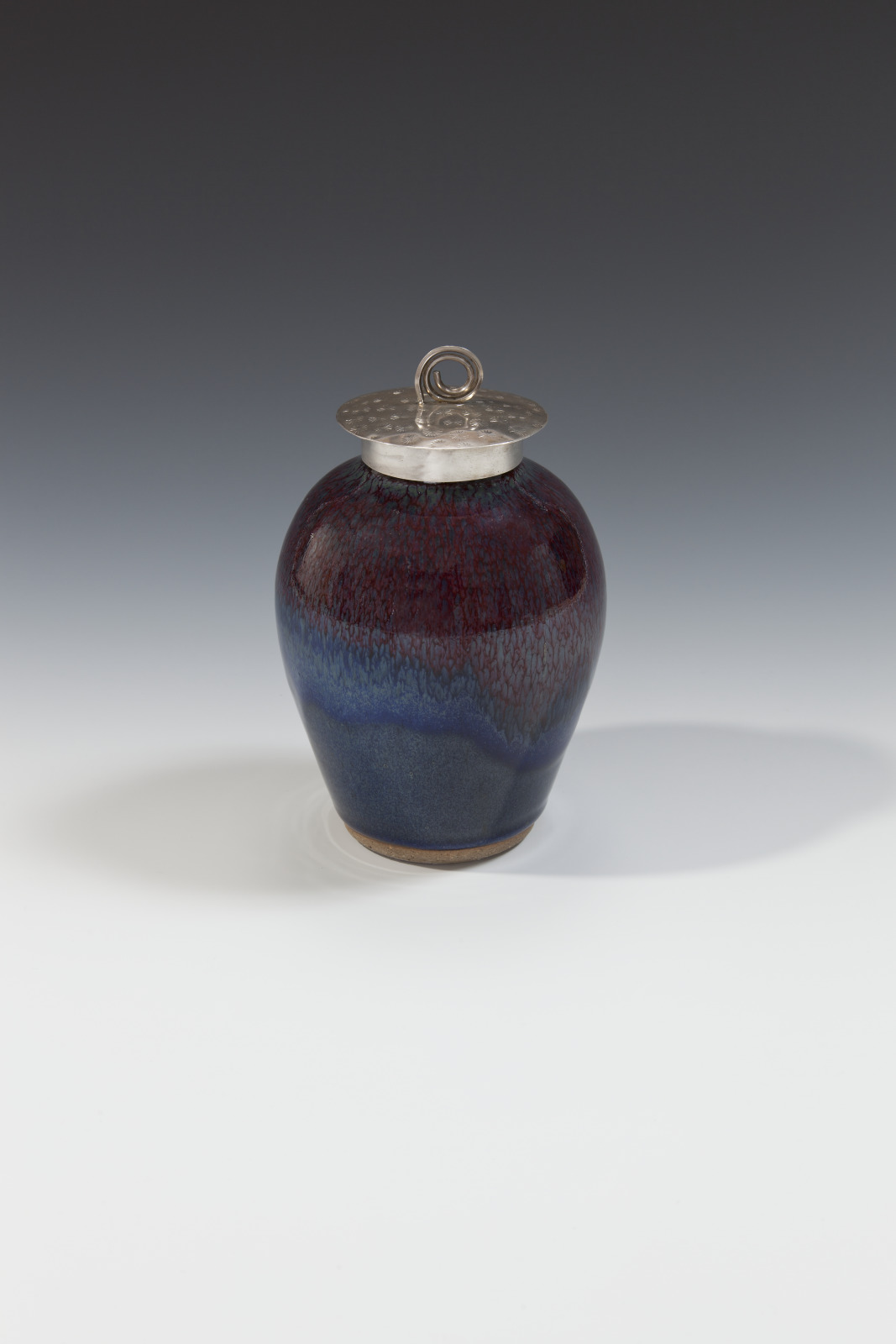
Pamela Owens (American, 1958-), Jugtown Pottery (Seagrove, NC, 1921-), Jennie L. Keatts (American). Jar with Lid, 2006, stoneware, silver, 6 x 4 inches. Gift of the Delhom Service League: 2006 Potters Market Invitational Purchase. 2006.67A-B. Copyright 2006, Pamela L Owens
On this lidded jar, Pam Owens has thrown a classic shape inspired by traditional Asian vases and complemented it with glazes in rich jewel tones of deep turquoise, burgundy, blue, and purple. The placement of the burgundy glaze around the jar’s shoulder highlights the elegance of its form. The jar’s small scale and silver lid further indicate that its purpose is decorative. The lid is by Jennie (Jennifer) Lorette Keatts, Pam’s sister, a jeweler in Seagrove, NC whose jewelry often features glazed ceramic “gems” made at Jugtown Pottery.
The Lorette sisters were raised in New Hampshire. Pamela first studied pottery there in 1975 and became an apprentice at Jugtown in 1977. After further apprenticeships in New Hampshire, she returned to Jugtown in 1980 and three years later married its owner Vernon Owens. Since then they have been the principal potters, as well as managers of this historic pottery, which was founded in 1921 by Jacques and Juliana Busbee. The Busbees were artists from Raleigh who sought to reinvigorate the North Carolina pottery tradition by introducing Asian forms and glazes. The grandfather of Ben Owen III, Ben Owen senior, worked at Jugtown Pottery as a potter from 1923 to 1959. Ben Owen and Vernon Owens are from the same family line, although Vernon’s grandfather added the ‘s’ to his name.
What’s the difference between pottery and ceramics?
Ceramics are clay objects that have been heated and chemically changed. Clay is porous and water-soluble, but ceramics are not. Pottery is a subcategory of ceramics that refers to vessels but not sculptures. The vessels can be functional or not. Pottery also has something of a rustic connotation, such that earthenware and stoneware are called pottery, whereas porcelain objects are called ceramics.